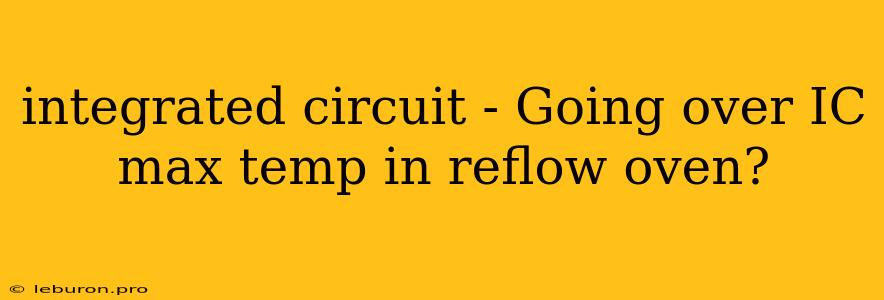The Perils of Exceeding Integrated Circuit Maximum Temperatures in Reflow Ovens
Reflow ovens are crucial tools in the electronics manufacturing process, providing a controlled environment for soldering surface-mount components onto printed circuit boards. One critical aspect of this process is ensuring the temperature profile of the oven remains within the specified limits for the components being soldered. Exceeding the maximum operating temperature, particularly for delicate integrated circuits (ICs), can lead to a range of detrimental effects, potentially jeopardizing the functionality and reliability of the final product.
Understanding IC Maximum Temperatures and Reflow Oven Profiles
Integrated circuits are designed to operate within a specific temperature range, typically defined by a maximum operating temperature (T<sub>J</sub>). This temperature limit represents the point beyond which the internal components of the IC, such as transistors and resistors, can experience irreversible damage. Exceeding this limit can lead to a cascade of problems including:
- Reduced lifespan: High temperatures accelerate the degradation of IC materials, shortening the overall lifespan of the device.
- Performance degradation: Elevated temperatures can impact the electrical characteristics of the IC, leading to decreased performance and potential malfunctions.
- Increased failure rate: Exceeding T<sub>J</sub> significantly increases the probability of permanent failure, leading to device malfunction and increased production scrap.
Reflow oven profiles are carefully designed to manage the temperature of the components throughout the soldering process. A typical profile includes a preheating stage, a ramp-up to the peak temperature (often known as the "soak zone"), and a controlled cool-down period. The peak temperature of the profile must be meticulously controlled to ensure it doesn't exceed the maximum operating temperature of the most sensitive components on the board, which often are integrated circuits.
Causes of Exceeding Maximum Temperatures in Reflow Ovens
Several factors can contribute to exceeding the maximum operating temperature of ICs during the reflow process. These include:
- Improper oven settings: Incorrectly configuring the oven profile, such as setting the peak temperature too high or the dwell time too long, can result in exceeding the IC maximum temperature.
- Poor thermal management: Inefficient heat dissipation from the board during the reflow process can lead to localized hot spots, potentially exceeding the IC T<sub>J</sub> even with the oven profile set correctly.
- Excessive component density: A high density of components on the board can create thermal bottlenecks, hindering heat dissipation and leading to localized temperature increases.
- Oven malfunction: Faulty sensors or control systems within the reflow oven can result in inaccurate temperature readings and uncontrolled heating, exceeding the IC maximum temperature.
Consequences of Exceeding IC Maximum Temperature
The consequences of exceeding the maximum operating temperature for an integrated circuit are multifaceted and can have significant implications for both the finished product and the production process.
- Functionality degradation: Elevated temperatures can lead to shifts in the electrical characteristics of the IC, potentially impacting its ability to perform its intended function. This can range from minor performance degradation to complete failure.
- Early failure: Long-term exposure to temperatures exceeding the maximum rating can accelerate material degradation, leading to premature failure of the IC. This can result in product defects and increased warranty claims.
- Production scrap: Significant temperature excursions can cause irreparable damage to the IC, rendering it unusable. This leads to increased production scrap and wasted resources.
- Increased cost: The combination of decreased yield, increased scrap, and potential warranty claims significantly increases the cost of production and reduces profitability.
Mitigation Strategies for Reflow Oven Temperature Issues
Preventing IC damage due to excessive temperatures during the reflow process requires a multi-pronged approach, focusing on both process control and component selection.
- Optimize oven profile: The reflow profile should be carefully calibrated for each specific board and component assembly, ensuring that the peak temperature remains within the limits of the most sensitive ICs.
- Improve thermal management: Employing techniques such as appropriate board design, using thermal vias, and applying thermal interface materials can improve heat dissipation and prevent localized hotspots.
- Component selection: Choosing ICs with higher maximum operating temperatures or utilizing components with built-in thermal protection mechanisms can increase the thermal tolerance of the assembly.
- Process monitoring: Regular monitoring and calibration of the reflow oven, including its sensors and control systems, are crucial for ensuring accurate temperature control.
- Inspection and testing: Performing thorough inspections and testing after the reflow process can identify any potential issues related to excessive temperature exposure.
Conclusion
Exceeding the maximum operating temperature of integrated circuits during reflow soldering can have significant consequences for the functionality, reliability, and overall cost of electronic products. By understanding the factors that can contribute to these temperature excursions and implementing appropriate mitigation strategies, manufacturers can minimize the risk of IC damage and ensure the successful production of high-quality electronic devices. Careful attention to oven profiles, component selection, thermal management, and process monitoring are all crucial elements in preventing IC damage and achieving optimal reflow soldering results.
